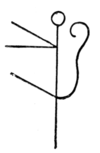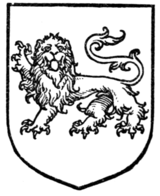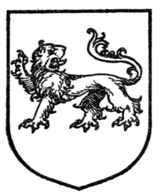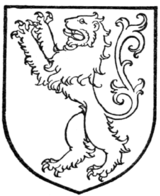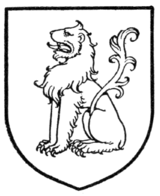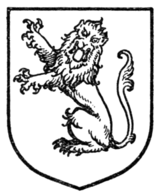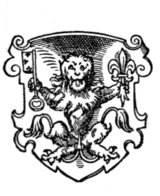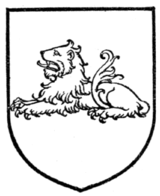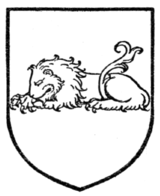CHAPTER XI
THE HERALDIC LION
HERALDIC art without the lion would not amount to very much, for no figure plays such an important or such an extensive part in armory as the lion, in one or other of its various positions. These present-day positions are the results of modern differentiation, arising from the necessity of a larger number of varying coats of arms; but there can be little doubt that in early times the majority of these positions did not exist, having been gradually evolved, and that originally the heraldic animal was just "a lion." The shape of the shield was largely a governing factor in the manner in which we find it depicted; the old artists, with a keener artistic sense than is evidenced in so many later examples of heraldic design, endeavoured to fill up as large a proportion of the space available as was possible, and consequently when only one lion was to be depicted upon the shield they very naturally drew the animal in an upright position, this being the one most convenient and adaptable for their purpose. Probably their knowledge of natural history was very limited, and this upright position would seem to them the most natural, and probably was the only one they knew; at any rate, at first it is almost the only position to be found. A curious commentary upon this may be deduced from the head-covering of Geoffrey of Anjou (Fig. 28), which shows a lion. This lion is identically of the form and shape of the lions rampant upon the shield, but from the nature of the space it occupies, is what would now be termed statant; but there is at the same time no such alteration in the relative position of the limbs as would now be required. This would seem to indicate very clearly that there was but the one stereotyped pattern of a lion, which answered all their purposes, and that our fore-runners applied that one pattern to the spaces they desired to decorate.
Early heraldry, however, when the various positions came into recognised use, soon sought to impose this definite distinction, that the lion could only be depicted erect in the rampant position, and that an animal represented to be walking must therefore be a leopard from the very position which it occupied. This, however, was a distinction known only to the more pedantic heralds, and found greatest favour amongst the French; but we find in Glover's Roll, which is a copy of a roll originally drawn up about the year 1250, that whilst he gives lions to six of the English earls, he commences with "le Roy d'Angleterre porte, Gules, trois lupards d'or." On the other hand, the monkish chronicler John of Harmoustier in Touraine (a contemporary writer) relates that when Henry I. chose Geoffrey, son of Foulk, Earl of Anjou, Touraine, and Main, to be his son-in-law, by marrying him to his only daughter and heir, Maud the Empress, and made him knight; after the bathing and other solemnities (pedes ejus solutaribus in superficie Leonculos aureos habentibus muniuntur), boots embroidered with golden lions were drawn on his legs, and also that (Clypeus Leonculos aureos imaginarios habens collo ejus suspenditur) a shield with lions of gold therein was hung about his neck.
It is, therefore, evident that the refinement of distinction between a lion and a leopard was not of the beginning; it is a later addition to the earlier simple term of lion. This distinction having been invented by French heralds, and we taking so much of our heraldry, our language, and our customs from France, adopted, and to a certain extent used, this description of lions passant as "leopards." There can be no doubt, however, that the lions passant guardant upon the English shield have always been represented as lions, no matter what they may have been called, and the use of the term leopard in heraldry to signify a certain position for the lion never received any extensive sanction, and has long since become obsolete in British armory. In French blazon, however, the old distinction is still observed, and it is curious to observe that on the coins of the Channel Islands the shield of arms distinctly shows three leopards. The French lion is our lion rampant, the French leopard is our lion passant guardant, whilst they term our lion passant a léopard-lionné, and our lion rampant guardant is their lion-léopardé.
A lion rampant and any other beast of prey is usually represented in heraldry with the tongue and claws of a different colour from the animal. If it is not itself gules, its tongue and claws are usually represented as of that colour, unless the lion be on a field of gules. They are then represented azure, the term being "armed and langued" of such and such a colour. It is not necessary to mention that a lion is "armed and langued" in the blazon when tongue and claws are emblazoned in gules, but whenever any other colour is introduced for the purpose it is better that it should be specified. Outside British heraldry a lion is always supposed to be rampant unless otherwise specifically described. The earliest appearance of the lions in the arms of any member of the Royal Family in England would appear to be the seal of King John when he was Prince and before he ascended the throne. This seal shows his arms to be two lions passant. The English Royal crest, which originated with Richard I., is now always depicted as a lion statant guardant. There can be no doubt, however, that this guardant attitude is a subsequent derivation from the position of the lions on the shield, when heraldry was ceasing to be actual and becoming solely pictorial. We find in the case of the crest of Edward the Black Prince, now suspended over his tomb in Canterbury Cathedral, that the lion upon the chapeau looks straight forward over the front of the helm (see Fig. 271).
Another ancient rule belonging to the same period as the controversy between leopards and lions was that there cannot be more than one lion upon a shield, and this was one of the great arguments used to determine that the charges on the Royal Arms of England must be leopards and not lions. It was admitted as a rule of British armory to a limited extent, viz., that when two or more lions rampant appeared upon the same shield, unless combatant, they were always formerly described as lioncels. Thus the arms of Bohun are: "Azure, a bend argent, cottised between six lioncels rampant or." British heraldry has, however, long since disregarded any such rule (if any definite rule ever really existed upon the point), though curiously enough in the recent grant of arms to the town of Warrington the animals are there blazoned six "lioncels."
The artistic evolution of the lion rampant can be readily traced in the examples and explanations which follow, but, as will be understood, the employment in the case of some of these models cannot strictly be said to be confined within a certain number of years, though the details and periods given are roughly accurate, and sufficiently so to typify the changes which have occurred.
Until perhaps the second half of the thirteenth century the body of the lion appears straight upright, so that the head, the trunk, and the left hind-paw fall into the angle of the shield. The left fore-paw is horizontal, the right fore- and the right hind-paw are placed diagonally (or obliquely) upwards (Fig. 272). The paws each end in three knobs, similar to a clover-leaf, out of which the claws come forth. The fourth or inferior toes appeared in heraldry somewhat later. The jaws are closed or only very slightly opened, without the tongue being visible. The tail is thickened in the middle with a bunch of longer hair and is turned down towards the body.
In the course of the period lasting from the second half of the thirteenth to the second half of the fourteenth centuries, the right hind-paw sinks lower until it forms a right angle with the left. The mouth 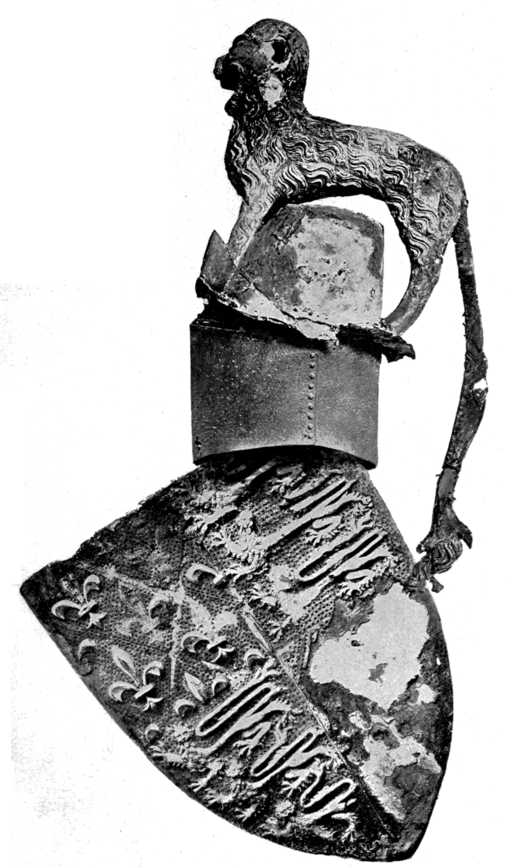
Fig. 271.—Shield, helmet, and crest of Edward the Black Prince, suspended over his tomb in Canterbury Cathedral.
In examples taken from the second half of the fourteenth century and the fifteenth century the lion's body is no longer placed like a pillar, but lays its head back to the left so that the right fore-paw falls into an oblique upward line with the trunk. The toes are lengthened, appearing almost as fingers, and spread out from one another; the tail, adorned with flame-like bunches of hair, strikes outwards and loses the before-mentioned knot, which only remains visible in a forked tail (queue-fourché). The jaws grow deep and are widely opened, and the breast rises and expands under the lower jaw (Fig. 274).
Lions of peculiar virility and beauty appear upon a fourteenth-century banner which shows the arms of the family of Talbot, Earls of Shrewsbury: Gules, a lion rampant within a bordure engrailed or, quartered with the arms of Strange: Argent, two lions passant in pale gules, armed and langued azure. Fig. 275 gives the lower half of the banner which was published in colours in the Catalogue of the Heraldic Exhibition in London, 1894.

Fig. 275.—Arms of Strange and Talbot. (From a design for a banner.)
Fig. 276 is an Italian coat of arms of the fourteenth century, and shows a lion of almost exactly the same design, except the paws are here rendered somewhat more heraldically. The painting (azure, a lion rampant argent) served as an "Ex libris," and bears the inscription "Libe accusacionum mey p. he ..." (The remainder has been cut away. It is reproduced from Warnecke's "German Bookplates," 1890.)
When we come to modern examples of lions, it is evident that the artists of the present day very largely copy lions which are really the creations of, or adaptations from, the work of their predecessors. The lions of the late Mr. Forbes Nixon, as shown in Fig. 277, which were specially drawn by him at my request as typical of his style, are respectively as follows:—
A winged lion passant coward. A lion rampant regardant. A lion rampant queue-fourché. A lion passant crowned. A lion passant. A lion rampant. A lion rampant to the sinister. A lion passant guardant, ducally gorged. A lion statant guardant, ducally crowned. A lion rampant. A lion statant guardant. A lion sejant guardant erect. Lions drawn by Mr. Scruby will be found in Figs. 278 and 279, which are respectively: "Argent, a lion rampant sable," "Sable, a lion passant guardant argent," and "Sable, a lion rampant argent." These again were specially drawn by Mr. Scruby as typical of his style.
The lions of Mr. Eve would seem to be entirely original. Their singularly graceful form and proportions are perhaps best shown by Figs. 280 and 281, which are taken from his book "Decorative Heraldry."
The lions of Mr. Graham Johnston can be appreciated from the examples in Figs. 284-9.
Examples of lions drawn by Miss Helard will be found in Figs. 282, 283.
The various positions which modern heraldry has evolved for the lions, together with the terms of blazon used to describe these positions, are as follows, and the differences can best be appreciated from a series drawn by the same artist, in this case Mr. Graham Johnston:—
Lion rampant.—The animal is here depicted in profile, and erect, resting upon its sinister hind-paw (see Fig. 284).
Lion rampant guardant.—In this case the head of the lion is turned to face the spectator (Fig. 285).

Fig. 277.—Lions. (Drawn by Mr. J. Forbes Nixon.)
Lion rampant regardant.—In this case the head is turned completely round, looking backwards (Fig. 286).
Lion rampant, double-queued.—In this case the lion is represented as having two tails (Fig. 287). These must both be apparent from the base of the tail, otherwise confusion will arise with the next example.
Lion rampant queue-fourché.—In this case one tail springs from the base, which is divided or "forked" in the centre (Fig. 288). There is no doubt that whilst in modern times and with regard to modern arms this distinction must be adhered to, anciently queue-fourché and double-queued were interchangeable terms.
Lion rampant tail nowed.—The tail is here tied in a knot (Fig. 289). It is not a term very frequently met with.
Lion rampant tail elevated and turned over its head.—The only instances of the existence of this curious variation (Fig. 290) which have come under my own notice occur in the coats of two families of the name of Buxton, the one being obviously a modern grant founded upon the other.
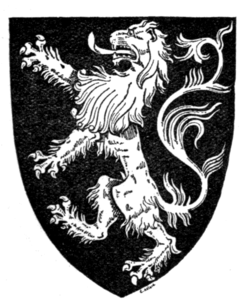 Fig. 282.—A lion rampant. (By Miss Helard.) |
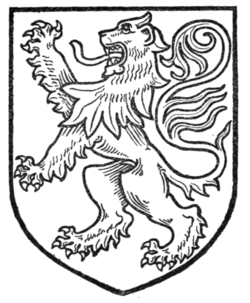 Fig. 283.—A lion rampant. (By Miss Helard.) |
Lion rampant with two heads.—This occurs (Fig. 291) in the coat of arms, probably founded on an earlier instance, granted in 1739 to Mason of Greenwich, the arms being: "Per fess ermine and azure, a lion rampant with two heads counterchanged." This curious charge had been adopted by Mason's College in Birmingham, and on the foundation of Birmingham University it was incorporated in its arms.
Lion rampant guardant bicorporated.—In this case the lion has one head and two bodies. An instance of this curious creature occurs in the arms of Attewater, but I am not aware of any modern instance of its use.
Lion Rampant Tricorporate.—In this case three bodies are united in one head (Fig. 292). Both this and the preceding variety are most unusual, but the tricorporate lion occurs in a coat of arms (temp. Car. II.) registered in Ulster's Office: "Or, a tricorporate lion rampant, the bodies disposed in the dexter and sinister chief points and in base, all meeting in one head guardant in the fess point sable."
Lion coward.—In this case the tail of the lion is depressed, passing between its hind legs (Fig. 293). The exactitude of this term is to some extent modern. Though a lion cowarded was known in ancient days, there can be no doubt that formerly an artist felt himself quite at liberty to put the tail between the legs if this seemed artistically desirable, without necessarily having interfered with the arms by so doing.

Fig. 294.—Armorial bearings of Alexander Charles Richards Maitland, Esq.: Or, a lion rampant gules, couped in all his joints of the field, within a double tressure flory and counterflory azure, a bordure engrailed ermine. Mantling gules and or. Crest: upon a wreath of his liveries, a lion sejant erect and affronté gules, holding in his dexter paw a sword proper, hilted and pommelled gold, and in his sinister a fleur-de-lis argent. Motto: "Consilio et animis."
Lion couped in all its joints is a charge which seems peculiar to the family of Maitland, and it would be interesting to learn to what source its origin can be traced. It is represented with each of its four paws, its head and its tail severed from the body, and removed slightly away therefrom. A Maitland coat of arms exhibiting this peculiarity will be found in Fig. 294.
Lions rampant combatant are so termed when two are depicted in one shield facing each other in the attitude of fighting (Fig. 295).
A very curious and unique instance of a lion rampant occurs in the arms of Williams (matriculated in Lyon Register in 1862, as the second and third quarterings of the arms of Sir James Williams Drummond of Hawthornden, Bt.), the coat in question being: Argent, a lion rampant, the body sable, the head, paws, and tuft of the tail of the field.
Lion passant.—A lion in this position (Fig. 296) is represented in the act of walking, the dexter forepaw being raised, but all three others being upon the ground.
Lion passant guardant.—This (Fig. 297) is the same as the previous position, except that the head is turned to face the spectator. The lions in the quartering for England in the Royal coat of arms are "three lions passant guardant in pale."
Lion of England.—This is "a lion passant guardant or," and the term is only employed for a lion of this description when it occurs as or in an honourable augmentation, then being usually represented on a field of gules. A lion passant guardant or, is now never granted to any applicant except under a specific Royal Warrant to that effect. It occurs in many augmentations, e.g. Wolfe, Camperdown, and many others; and when three lions passant guardant in pale or upon a canton gules are granted, as in the arms of Lane (Plate II.), the augmentation is termed a "canton of England."
Lion passant regardant is as the lion passant, but with the head turned right round looking behind (Fig. 298). A lion is not often met with in this position.
Lions passant dimidiated.—A curious survival of the ancient but now obsolete practice of dimidiation is found in the arms of several English seaport towns. Doubtless all can be traced to the "so-called" arms of the "Cinque Ports," which show three lions passant guardant dimidiated with the hulks of three ships. There can be no doubt whatever that this originally came from the dimidiation of two separate coats, viz. the Royal Arms of England (the three lions passant guardant), and the other "azure, three ships argent," typical of the Cinque Ports, referring perhaps to the protection of the coasts for which they were liable, or possibly merely to their seaboard position. Whilst Sandwich[1] uses the two separate coats simply dimidiated upon one shield, the arms of Hastings[2] vary slightly, being: "Party per pale gules and azure, a lion passant guardant or, between in chief and in base a lion passant guardant of the last dimidiated with the hulk of a ship argent." From long usage we have grown accustomed to consider these two conjoined and dimidiated figures as one figure (Fig. 299), and in the recent grant of arms to Ramsgate[3] a figure of this kind was granted as a simple charge.
The arms of Yarmouth[4] afford another instance of a resulting figure of this class, the three lions passant guardant of England being here dimidiated with as many herrings naiant.
Lion statant.—The distinction between a lion passant and a lion statant is that the lion statant has all four paws resting upon the ground. The two forepaws are usually placed together (Fig. 300). Whilst but seldom met with as a charge upon a shield, the lion statant is by no means rare as a crest.
Lion statant tail extended.—This term is a curious and, seemingly, a purposeless refinement, resulting from the perpetuation in certain cases of one particular method of depicting the crest—originally when a crest a lion was always so drawn—but it cannot be overlooked, because in the crests of both Talbot, Earl of Shrewsbury, and Percy, Duke of Northumberland, the crest is now stereotyped as a lion in this form (Fig. 301) upon a chapeau.
Lion statant guardant (Fig. 302).—This (crowned) is of course the Royal crest of England, and examples of it will be found in the arms of the Sovereign and other descendants, legitimate and illegitimate, of Sovereigns of this country. An exceptionally fine rendering of it occurs in the Windsor Castle Bookplates executed by Mr. G. W. Eve.
Lion salient.—This, which is a very rare position for a lion, represents it in the act of springing, the two hind legs being on the ground, the others in the air (Fig. 303).
Lion salient guardant.—There is no reason why the lion salient may not be guardant or regardant, though an instance of the use of either does not come readily to mind.
Lion sejant.—Very great laxity is found in the terms applied to lions sejant, consequently care is necessary to distinguish the various forms. The true lion sejant is represented in profile, seated on its haunches, with the forepaws resting on the ground (Fig. 304).
Lion sejant guardant.—This is as the foregoing, but with the face (only) turned to the spectator (Fig. 305).
Lion sejant regardant.—In this the head is turned right back to gaze behind (Fig. 306).
Lion sejant erect (or, as it is sometimes not very happily termed, sejant-rampant).—In this position the lion is sitting upon its haunches, but the body is erect, and it has its forepaws raised in the air (Fig. 307).
Lion sejant guardant erect is as the last figure, but the head faces the spectator (Fig. 308).
Lion sejant regardant erect is as the foregoing, but with the head turned right round to look backwards (Fig. 309).
Lion sejant affronté.—In this case the lion is seated on its haunches, but the whole body is turned to face the spectator, the forepaws resting upon the ground in front of its body. Ugly as this position is, and impossible as it might seem, it certainly is to be found in some of the early rolls.
Lion sejant erect affronté (Fig. 294).—This position is by no means unusual in Scotland. A lion sejant erect and affronté, &c., is the Royal crest of Scotland, and it will also be found in the arms of Lyon Office.
A good representation of the lion sejant affronté and erect is shown in Fig. 310, which is taken from Jost Amman's Wappen und Stammbuch (1589). It represents the arms of the celebrated Lansquenet Captain Sebastian Schärtlin (Schertel) von Burtenbach ["Gules, a lion sejant affronté erect, double-queued, holding in its dexter paw a key argent and in its sinister a fleur-de-lis"]. His victorious assault on Rome in 1527, and his striking successes against France in 1532, are strikingly typified in these arms, which were granted in 1534.
Lion Couchant.—In this position the lion is represented lying down, but the head is erect and alert (Fig. 311).
Lion dormant.—A lion dormant is in much the same position as a lion couchant, except that the eyes are closed, and the head rests upon the extended forepaws (Fig. 312). Lions dormant are seldom met with, but they occur in the arms of Lloyd, of Stockton Hall, near York.
Lion morné.—This is a lion without teeth and claws, but no instance of the use of the term would appear to exist in British armory. Woodward mentions amongst other Continental examples the arms of the old French family of De Mornay ["Fascé d'argent et de gueules au lion morné de sable, couronné d'or brochant sur le tout"].
Lions as supporters.—Refer to the chapter on Supporters.
Winged lion.—The winged lion—usually known as the lion of St. Mark—is not infrequently met with. It will be found both passant and sejant, but more frequently the latter (Fig. 313). The true lion of St. Mark (that is, when used as a badge for sacred purposes to typify St. Mark) has a halo. Winged lions are the supporters of Lord Braye.
Sea lion (or, to use another name for it, a morse) is the head, forepaws, and upper part of a lion conjoined to the tail of a fish. The most frequent form in which sea lions appear are as supporters, but they are also met with as crests and charges. When placed horizontally they are termed naiant. Sea lions, however, will also be found "sejant" and "sejant-erect" (Fig. 314). When issuing from waves of the sea they are termed "assurgeant."
Lion-dragon.—One hesitates to believe that this creature has any existence outside heraldry books, where it is stated to be of similar form and construction to the sea lion, the difference being that the lower half is the body and tail of a wyvern. I know of no actual arms or crest in which it figures.
 Fig. 313.—Winged lion. |
 Fig. 314.—Sea lion. |
 Fig. 315.—Man-Lion. |
Man-lion or man-tiger.—This is as a lion but with a human face. Two of these are the supporters of Lord Huntingdon, and one was granted to the late Lord Donington as a supporter, whilst as charges they also occur in the arms of Radford. This semi-human animal is sometimes termed a "lympago" (Fig. 315).
Other terms relating to lions occur in many heraldic works—both old and new—but their use is very limited, if indeed of some, any example at all could be found in British armory. In addition to this, whilst the fact may sometimes exist, the term has never been adopted or officially recognised. Personally I believe most of the terms which follow may for all practical purposes be entirely disregarded. Amongst such terms are contourné, applied to a lion passant or rampant to the sinister. It would, however, be found blazoned in these words and not as contourné. "Dismembered," "Demembré," "Dechaussée," and "Trononnée" are all "heraldry-book" terms specified to mean the same as "couped in all its joints," but the uselessness and uncertainty concerning these terms is exemplified by the fact that the same books state "dismembered" or "demembré" to mean (when applied to a lion) that the animal is shown without legs or tail. The term "embrued" is sometimes applied to a lion to signify that its mouth is bloody and dropping blood; and "vulned" signifies wounded, heraldically represented by a blotch of gules, from which drops of blood are falling. A lion "disarmed" is without teeth, tongue, or claws.
A term often found in relation to lions rampant, but by no means peculiar thereto, is "debruised." This is used when it is partly defaced by another charge (usually an ordinary) being placed over it.
Another of these guide-book terms is "decollated," which is said to be employed in the case of a lion which has its head cut off. A lion "defamed" or "diffamed" is supposed to be rampant to the sinister but looking backwards, the supposition being that the animal is being (against his will) chased off the field with infamy. A lion "evire" is supposed to be emasculated and without signs of sex. In this respect it is interesting to note that in earlier days, before mock modesty and prudery had become such prominent features of our national life, the genital organ was always represented of a pronounced size in a prominent position, and it was as much a matter of course to paint it gules as it now is to depict the tongue of that colour. To prevent error I had better add that this is not now the usual practice.
Lions placed back to back are termed "endorsed" or "addorsed," but when two lions passant in pale are represented, one passing to the dexter and one to the sinister, they are termed "counter-passant." This term is, however, also used sometimes when they are merely passant towards each other. A more correct description in such cases would be passant "respecting" or "regarding" each other.
The term lionné is one stated to be used with animals other than lions when placed in a rampant position. Whilst doubtless of regular acceptation in French heraldry as applied to a leopard, it is unknown in English, and the term rampant is indifferently applied; e.g. in the case of a leopard, wolf, or tiger when in the rampant position.
Lionced is a term seldom met with, but it is said to be applied (for example to a cross) when the arms end in lions' heads. I have yet to find an authentic example of the use of such a cross.
When a bend or other ordinary issues from the mouths of lions (or other animals), the heads issuing from the edges or angles of the escutcheon, the ordinary is said to be "engouled."
A curious term, of the use of which I know only one example, is "fleshed" or "flayed." This, as doubtless will be readily surmised, means that the skin is removed, leaving the flesh gules. This was the method by which the supporters of Wurtemburg were "differenced" for the Duke of Teck, the forepaws being "fleshed."
Woodward gives the following very curious instances of the lion in heraldry:—
"Only a single example of the use of the lioness as a heraldic charge is known to me. The family of Coing, in Lorraine, bears: d'Azure, à une lionne arrêtée d'or.
"The following fourteenth-century examples of the use of the lion as a heraldic charge are taken from the oft-quoted Wappenrolle von Zurich, and should be of interest to the student of early armory:—
"51: End: Azure, a lion rampant-guardant argent, its feet or.
"305. Wildenvels: Per pale argent and sable, in the first a demi-lion statant-guardant issuant from the dividing line.
"408. Tannenvels: Azure, a lion rampant or, queué argent.
"489. Rinach: Or, a lion rampant gules, headed azure.
"A curious use of the lion as a charge occurs in several ancient coats of the Low Countries, e.g. in that of Trasegnies, whose arms are: Bandé d'or et d'azur, à l'ombre du lion brochant sur le tout, à la bordure engrêlée d'or. Here the ombre du lion is properly represented by a darker shade of the tincture (either of or or of azure), but often the artist contents himself with simply drawing the outline of the animal in a neutral tint.
"Among other curiosities of the use of the lion are the following foreign coats:—
"Boissiau, in France, bears: De gueules, semé de lions d'argent.
"Minutoli, of Naples: Gules, a lion rampant vair, the head and feet or.
"Loen, of Holland: Azure, a decapitated lion rampant argent, three jets of blood spurting from the neck proper.
"Papacoda, of Naples: Sable, a lion rampant or, its tail turned over its head and held by its teeth.
"The Counts Reinach, of Franconia: Or, a lion rampant gules, hooded and masked azure (see above)."
To these instances the arms of Westbury may well be added, these being: Quarterly, or and azure, a cross patonce, on a bordure twenty lions rampant all counter-changed. No doubt the origin of such a curious bordure is to be found in the "bordure of England," which, either as a mark of cadency or as an indication of affinity or augmentation, can be found in some number of instances. Probably one will suffice as an example. This is forthcoming in Fig. 61, which shows the arms of John de Bretagne, Earl of Richmond. Of a similar nature is the bordure of Spain (indicative of his maternal descent) borne by Richard of Conisburgh, Earl of Cambridge, who bore: Quarterly France and England, a label of three points argent, each charged with 
Fig. 317.—Arms of Bohemia, from the "Pulver Turme" at Prague. (Latter half of the fifteenth century.)

Fig. 316.—Arms of Richard of Conisburgh, Earl of Cambridge. (From MS. Cott., Julius C. vii.)
Before leaving the lion, the hint may perhaps be usefully conveyed that the temptation to over-elaborate the lion when depicting it heraldically should be carefully avoided. The only result is confusion—the very contrary of the essence of heraldic emblazonment, which was, is, and should be, the method of clear advertisement of identity. Examples of over-elaboration can, however, be found in the past, as will be seen from Fig. 317. This example belongs to the latter half of the fifteenth century, and represents the arms of Bohemia. It is taken from a shield on the "Pulver Turme" at Prague.
Parts of lions are very frequently to be met with, particularly as crests. In fact the most common crest in existence is the demi-lion rampant (Fig. 318). This is the upper half of a lion rampant. It is comparatively seldom found other than rampant and couped, so that the term "a demi-lion," unless otherwise qualified, may always be assumed to be a demi-lion rampant couped. As charges upon the shield three will be found in the arms of Bennet, Earl of Tankerville: "Gules, a bezant between three demi-lions rampant argent."
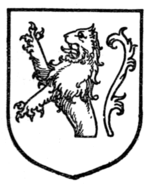 |
 |
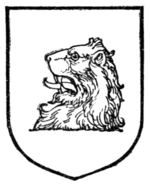
|
| Fig. 318.—A demi-lion rampant. | Fig. 319.—A demi-lion passant. | Fig. 320.—A lion's head couped. |
The demi-lion may be both guardant and regardant.
Demi-lions rampant and erased are more common as charges than as crests. They are to be found in several Harrison coats of arms.
Demi-lions passant (Fig. 319) are rather unusual, but in addition to the seeming cases in which they occur by dimidiation they are sometimes found, as in the case of the arms of Newman.
Demi-lion affronté.—The only case which has come under notice would appear to be the crest of Campbell of Aberuchill.
Demi-lion issuant.—This term is applied to a demi-lion when it issues from an ordinary, e.g. from the base line of the chief, as in the arms of Dormer, Markham, and Abney; or from behind a fesse, as in the arms of Chalmers.
Demi-lion naissant issues from the centre of an ordinary, and not from behind it.
Lions' heads, both couped (Fig. 320) and erased, are very frequently met with both as charges on the shield and as crests.
Lion's gamb.—Many writers make a distinction between the gamb (which is stated to be the lower part only, couped or erased half-way up the leg) and the paw, but this distinction cannot be said to be always rigidly observed. In fact some authorities quote the exact reverse as the definition of the terms. As charges the gamb or paw will be found to occur in the arms of Lord Lilford ["Or, a lion's gamb erased in bend dexter between two crosslets fitchée in bend sinister gules"], and in the arms of Newdigate. This last is a curious example, inasmuch as, without being so specified in the blazon, the gambs are represented in the position occupied by the sinister foreleg of a lion passant.
The crest upon the Garter Plate of Edward Cherleton, Lord Cherleton of Powis, must surely be unique. It consists of two lions' paws embowed, the outer edge of each being adorned with fleurs-de-lis issuant therefrom.
A lion's tail will sometimes be found as a crest, and it also occurs as a charge in the arms of Corke, viz.: "Sable, three lions' tails erect and erased argent."
A lion's face (Fig. 321) should be carefully distinguished from a lion's head. In the latter case the neck, either couped or erased, must be shown; but a lion's face is affronté and cut off closely behind the ears. The distinction between the head and the face can be more appropriately considered in the case of the leopard.
- ↑ Arms of Sandwich: Party per pale gules and azure, three demi-lions passant guardant or, conjoined to the hulks of as many ships argent.
- ↑ Arms of Hastings: Party per pale gules and azure, a lion passant guardant or, between in chief and in base a lion passant guardant or, dimidiated with the hulk of a ship argent.
- ↑ Arms of Ramsgate: Quarterly gules and azure, a cross parted and fretty argent between a horse rampant of the last in the first quarter, a demi-lion passant guardant of the third conjoined to the hulk of a ship or in the second, a dolphin naiant proper in the third, and a lymphad also or in the fourth. Crest: a naval crown or, a pier-head, thereon a lighthouse, both proper. Motto: "Salus naufragis salus ægris."
- ↑ Arms of Yarmouth: Party per pale gules and azure, three demi-lions passant guardant or, conjoined to the bodies of as many herrings argent. Motto: "Rex et nostra jura."
